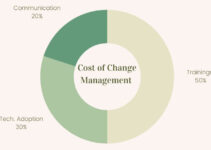Change management comes with a lot of risk factors and they could potentially jeopardize the growth and success of the entire change project. The risk factor is due to various external sources like industry environment, regulation, and competition; internal sources like stakeholders involvement, personal process change, and structure. Today, we’ll discuss the change management risk register; its benefits, definition of risk register, and steps involved in registering for change management.
Risk Register is a documentary record that manages, recognizes, tracks, and analyzes risk factors as a part of the risk management process. It is a great tool for risk recognition and risk analysis. You could employ the risk register to recognize, analyze, and communicate the risk information relevant to the particular project and initiative in an organizational manner.
Addressing Change Management Risks
- Recognizing risk factors
- Performing risk analysis
- Tracking and monitoring risks
- Developing a risk response plan
- Risk communication
- Implementing risk mitigation steps
Purpose of Risk Register
- Larger and longer projects are complex and they require you to have a risk register
- Highly difficult to monitor and manage risk in every area
- You’re flying blindly without a risk register and could derail easily and face various challenges
- Helps you to track all the possible risks relevant to the project and makes sure to manage them effectively
- Not tracking the risk from the central location and reviewing it regularly, you could miss and forget things easily
Steps in Change Management Risk Register
Let’s discuss the main steps involved in the change management risk register; they’re as follows;
Describing Risks
First of all, you should recognize and describe the potential risk factors. There are multiple types of risks, and those risks come from both internal and external sources. You should analyze and track all the potential risk factors and become ready and prepared for any type of unexpected incident. The organizational team members sit together and brainstorm various ideas to recognize risk factors. You should invite external stakeholders to clearly recognize and describe the risks of the change project.
Analyzing Risk
Risk analysis is the method of finding the impact of potential risk factors. Change management risk analysis comprises recognizing and analyzing the potential risk factors relevant to the change project and finding the riskiness of every factor. However, it allows you to recognize the potential risk factors that would occur when managing and mitigating them.
You should categorize and divide the risks at various levels like low risks, medium risks, and higher risks.
- Low Risks: low-risk factors have a limited probability of occurrence and they have a limited impact on the change project; they cause delays, small changes, and cost
- High Risks: they have a high probability of occurrence and they could significantly impact the entire change project; they cause higher delays in the project, big changes, and high-cost impact
Taking Mitigation Actions
You could employ the risk register to take mitigation steps to decrease the risk factors. It comprises recording and documenting the potential risk responses and executing strategies to address the risk factors and decrease their impact. However, you should document the risk mitigation plan in the risk register and it serves as a roadmap and guideline. It consists of developing risk response strategies that you could execute to address the risk factors and decrease their impact. The focus of the risk mitigation plan is on risk strategies, risk responses, risk impact, and risk probability.
Owner and Delegation
Once you have analyzed and recognized the risk factors, then you should assign and allocate the risk to the owner to manage risk. The risk register should include the risk owner’s name and the person responsible for managing and analyzing the risk throughout the change project. The risk owners have the experience, skill, and expertise to manage risks, recognize risks, and develop strategies to decrease them.
Targeted Date
The risk register should have the data and record of developing a risk mitigation action plan. It plays a key role in risk management, monitoring and evaluating the risk factors continuously, and implementing the actions regularly. It plays a key role in managing risks, making sure that you are evaluating potential risk factors continuously and taking steps on time. Setting a precise date for risk factors would help you to avoid the adverse impact of the change project.
The date for the risk mitigation needs to be realistic, measurable, and time-bound, and they help risk owners evaluate the risk through the lifecycle of the change project.
Complete Status
The risk register manages and tracks the status of risk mitigation activities. It comprises analyzing and tracking the risk mitigation plan after its completion, and it requires you to engage in risk mitigation activities. It is significant to regularly analyze the risk mitigation action plan and update the risk register accordingly.
Benefits of Risk Register for Change Management
Some of the main benefits of a change management risk register are as follows;
- Allows you to avoid the adverse impact on the change project through the risk mitigation plan
- Great tool to recognize the potential risk factors and evaluate the risks throughout the lifecycle of the change project
- Helps you to track and analyze the activities of the risk mitigation action plan
- Informing all the stakeholders about the risk status
Conclusion: Risk Register for Change Management
After an in-depth study of the change management risk register; we have realized that the risk register is highly significant for managing risk factors. If you are learning about the risk register for change management; then you should keep in mind the abovementioned benefits, steps involved in the risk register development process, and others.
Ahsan is an accomplished researcher and has a deep insight in worldly life affairs. He goes Live 3 days a week on various social media platforms. Other than research writing, he’s a very interesting person.


